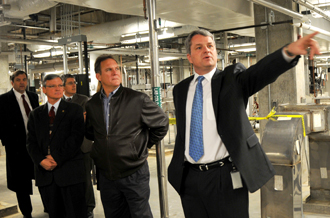Research Thrives in Piney Woods
Not even Hurricane Katrina could stop the phenomenal growth and research progress at the Tulane National Primate Research Center in Covington, La. Since the storm, the facility has almost doubled in size and increased research funding by more than 40 percent.

Andrew Lackner, right, director of the Tulane National Primate Research Center, leads a tour of the center's new Regional Biosafety Laboratory at its 2008 dedication ceremony. (Photo by Sally Asher)
“Our grant funding has gone up every single year except 2006,” says Andrew Lackner, primate center director. “And since then we've been on a tear. This last year we hit $40 million in grant funding without any construction grants, which is phenomenal.”
Before the storm, the center had roughly $28 million in grant funding, most of which came from the National Institutes of Health.
Hurricane Katrina's fierce winds and rain battered trees and knocked out power for the center, but the 500-acre campus on the North Shore of Lake Pontchartrain didn't flood and never stopped operations. The facility, one of only eight NIH-funded primate research centers in the nation, didn't lose any of its 5,000 primates and resumed research operations roughly three weeks after the storm.
The center now employs about 300 people. Before the storm, it was embarking on an aggressive $70 million growth plan. In 2008, it opened a $27.5 million, 38,800-square-foot Regional Biosafety Laboratory to study emerging infectious diseases and potential agents of bioterrorism.
The building is next to a new 14,400-square-foot animal holding facility and across from a 23,000-square-foot animal research building, which is under construction. The new buildings have increased the center's total square footage to almost 190,000 and represent more than $50 million in new construction.
The Regional Biosafety Lab is one of only 13 NIH-supported Regional Biosafety level three laboratories in the country, and the only one affiliated with a national primate research center, medical school and school of public health and tropical medicine. Biosafety level three is a national designation for labs designed and managed with numerous safeguards to assure containment for the study of airborne bacteria, viruses and toxins.
